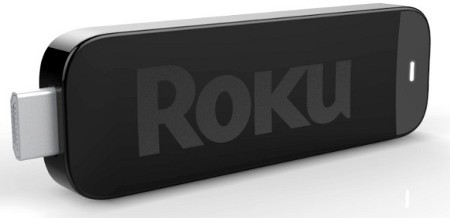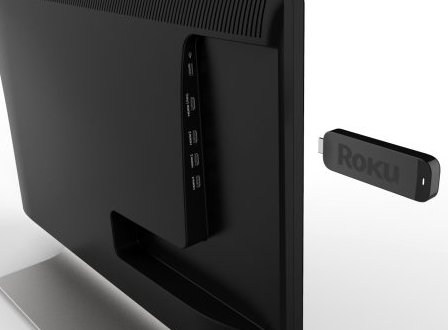Roku media player shrinks again — to an HDMI dongle
Jan 4, 2012 — by Eric Brown — from the LinuxDevices Archive — 10 viewsRoku announced a tiny dongle version of its Linux-based streaming player device, designed to plug directly into a TV's HDMI port. Due to ship in the fall, the “Roku Streaming Stick” will send its signals to — and accept power from — Mobile High Definition Link-enabled televisions, including some of Best Buy's Insignia models.
Only six months after shrinking its Linux-based Roku media player boxes to 3.3 x 3.3 x 0.9 inches with the Roku 2, Roku has cranked up its miniaturization machine again to produce an even smaller, simpler model.
Although Roku does not list the dimensions for the Roku Streaming Stick, it is said to be the size of a USB flash drive. Instead of being built around a USB port, however, it offers an HDMI port that plugs directly into its counterpart on an HDTV, says Roku.

Roku Streaming Stick
Roku has accomplished its remarkable shrinking act by requiring TVs that have HDMI ports equipped with the new MHL (mobile high-definition link) technology. MHL lets the TV supply power to peripheral devices over HDMI in an approach similar to Power over Ethernet (PoE).

Roku Streaming Stick ready to power up via an MHL-enabled HDMI port on an Insignia HDTV
MHL has been "adopted" by nearly 100 hardware and manufacturing vendors, according to Roku. These are said to include the MHL Consortium's joint founders: Nokia, Samsung, Silicon Image, Sony, and Toshiba. MHL is already supported by over a dozen devices, primarily Android smartphones, including the HTC Rezound, according to a list posted on Wikipedia.
However, it might be easier finding an MHL-enabled smartphone than an MHL-ready TV. The possibly dated Wikipedia story says that only the Toshiba Regza WL800A LED TV and Samsung's UN55D8000YF and UN55D6300SF LED TV range are currently shipping with the technology.
Some of Best Buy's Insignia brand TVs, however, will be available with MHL by the time the Roku Streaming Stick ships this fall, says Roku. The Roku device will be offered with the Insignia TVs, presumably as an extra-cost option.
According to Roku, the Roku Streaming Stick can help TV manufacturers and their consumers keep up to date with "smart TV" functionality. While TVs generally have a lifespan of six to eight years, IPTV technology changes much more rapidly. Manufacturers who integrate such technology in their TVs run the risk of rapid obsolescence, argues Roku.
"By moving the streaming platform to a stick that's easily replaceable, consumers no longer have to worry about their large-screen Smart TV becoming obsolete before its time," says the company.
 This would suggest that the Roku Streaming Stick will be at least as affordable as its manufacturer's current systems — the $50 Roku LT is pictured at right, dwarfed by its remote controller. Roku, however, has not released pricing or other technical details.
This would suggest that the Roku Streaming Stick will be at least as affordable as its manufacturer's current systems — the $50 Roku LT is pictured at right, dwarfed by its remote controller. Roku, however, has not released pricing or other technical details.
Like the other Roku devices, the Roku Streaming Stick will feature free, automatic software updates and channel enhancements, says Roku. Roku's lineup now incorporates more than 400 channels, including Netflix, Amazon Instant Video, Hulu Plus, Pandora, Angry Birds, and most recently, HBO GO.
The $50 Roku LT, announced in October, joined three revised Roku 2 boxes released in July. Like the Roku LT, the $60 Roku 2 HD is limited to 720p playback. The Roku 2 XD ($80) moves up to 1080p, and the Roku 2 XS ($100) adds USB and Ethernet ports as well as a motion-control remote and Angry Birds. Presumably, the Roku Streaming Stick will support 1080p, although this was not made clear in the announcement.
Stated Greg Peters, vice president at Netflix, "Roku is taking streaming innovation to the next level and giving consumers a seamless Smart TV experience. The Roku Streaming Stick allows us to deliver the Netflix experience found on the Roku platform to potentially any TV."
Stated Kurt Scherf, vice president and principal analyst at Parks Associates, "The Roku Streaming Stick is a game changer for the Smart TV market. It takes the leading streaming platform and integrates into the TV in a way that no one has been able to do."
Availability
The Roku Streaming Stick will be available this fall, both bundled with an Insignia TV in retail or sold separately for consumers to use with their own MHL-enabled TVs, says Roku. More information should eventually appear at Roku's website.
This article was originally published on LinuxDevices.com and has been donated to the open source community by QuinStreet Inc. Please visit LinuxToday.com for up-to-date news and articles about Linux and open source.